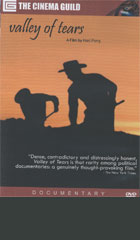
Valley of Tears 2005
Distributed by Cinema Guild, 115 West 30th Street, Suite 800, New York, NY 10001; 212-685-6242
Produced by Hart Perry
Directed by Hart Perry
DVD, color, 80 min.
Sr. High - Adult
Area Studies, Human Rights, Labor Relations
Date Entered: 07/26/2007
Reviewed by Veronica Maher, Roger Williams University, Bristol, Rhode IslandTouting itself today as the “Gateway to Rio Grande Valley,” Raymondville, Texas is a mostly Hispanic (86.63% according to the 2000 census) border town of less then ten thousand, who take pride in their geographic location and sense of community. The Chamber of Commerce webpage describes Raymondville as “The City with a Smile.” However it hasn’t always been described with such pleasantries.
In 1979 Raymondville was hyped as the Onion Capital of the World. The Valley of Tears provides a look at what was happening then. It is not a nice picture. The Mexican-American migrant workers who labored in the onion fields were earning pay at below minimum wage; they finally united to protest the low wages, which had remained stagnant for over a decade. The strike was broken when the owner sold the crop to a larger competitor. To their credit, the workers tried to unite and improve their lot, but the strike changed the playing field. The local white community of landholders and city officials manipulated the Hispanic population, who were undereducated and underrepresented in the local government. The lack of educational services for these mostly Spanish speaking Mexican Americans was at issue, as well as topsy turvy community leadership.
The film jumps forward to a more recent political view and we learn that although many changes have occurred a lot of the cultural and economic problems still exist. A few of the participants in the ’79 strike still reside in the county and feel that, despite the loss, it was a good thing because it provided a voice for the workers to organize and petition for more rights, after all they are American citizens.
At eighty minutes the film is a bit too long to hold the attention of high schoolers, but it could be useful to students studying the border towns and their evolution or the history of labor movements among Hispanic cultures. Much of the footage is actual film from 1979 and there are some interesting scenes of confrontation between the players. Divided into three parts: the strike; education problems; and more recent political issues, it certainly could arouse a further interest in this and other borderlands in the Southwest.